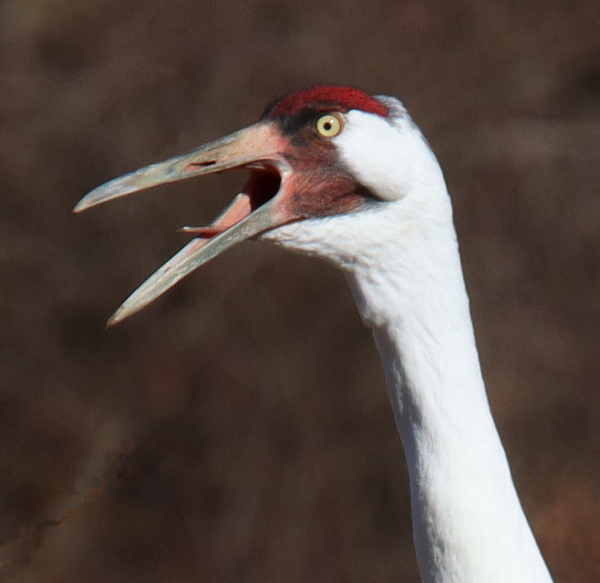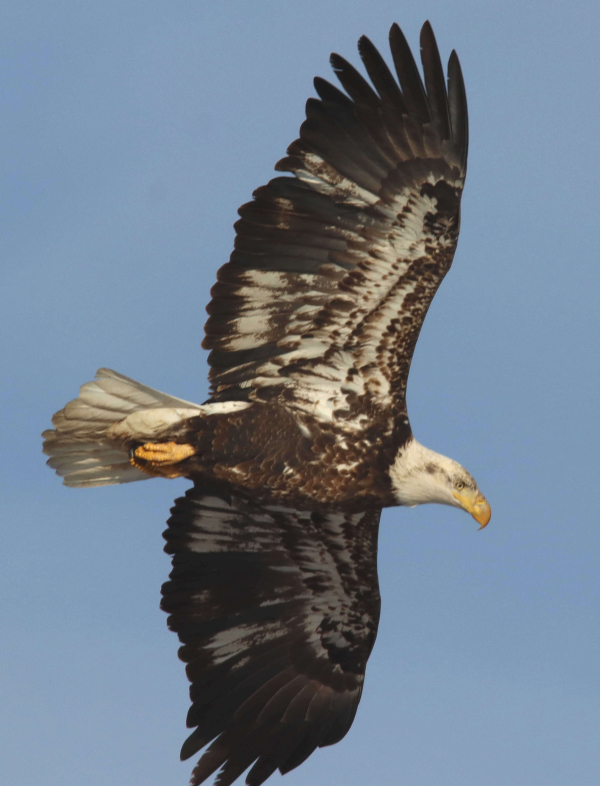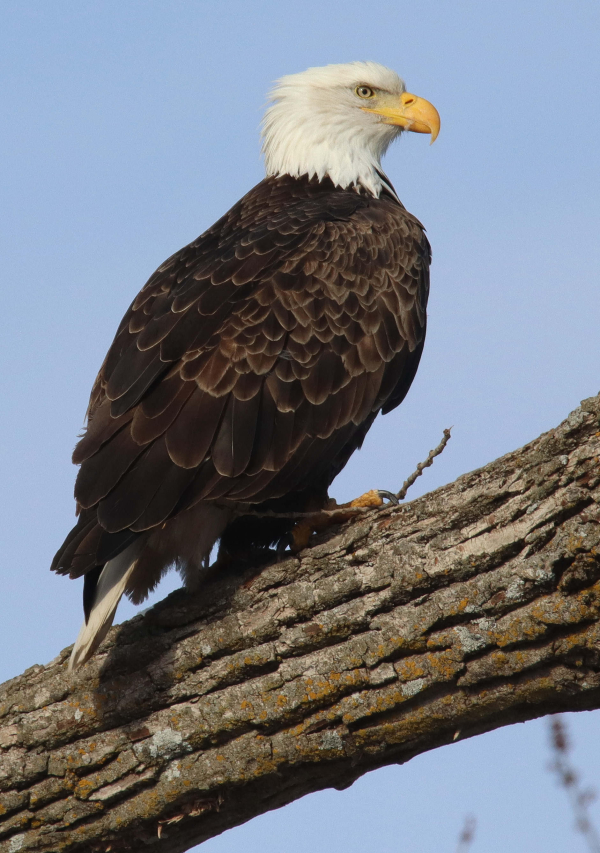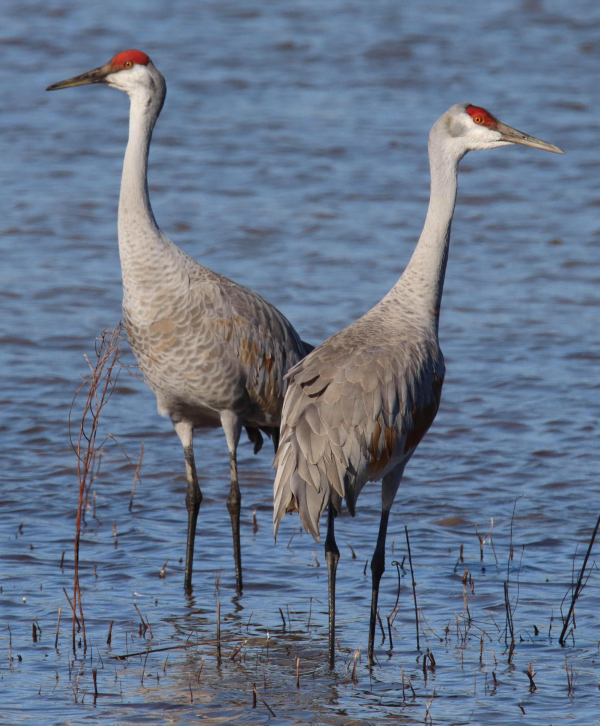
A surprising close sighting of an adult Whooping Crane resulted in a number of photos, including this close focus image of it trumpeting in response to a nearby Sandhill Crane interaction.

A near-adult Bald Eagle showed an interesting amount white color in its underwing plumage, which wasn’t evident when the 4th-year eagle was perched.

Several Bald Eagles were present at Loess Bluffs Refuge in Missouri, attracted by flocks of Mallards, Canada Geese, and Trumpeter Swans.

A family group of Trumpeter Swans was feeding below the water surface in a small opening in the morning ice.

A pair of Sandhill Cranes provide a front and back portrait of the gray crane species wintering at Wheeler Refuge in Alabama (see the Bird Photography feature in this issue for more crane images).
|
Winter migration began last Wednesday for this big bird, traveling south across the Dakotas to follow the Missouri River Valley the first 600 miles. First stop was Loess Bluffs National Wildlife Refuge in northwest Missouri, a stronghold for migrating Snow Geese and Bald Eagles during fall and spring, building to more than a million geese and a high count of 660 eagles at peak times – huge numbers for any location! But what birds would a January visit yield? After sunrise the light cloud cover began breaking up, revealing swans – Trumpeter Swans – along with Canada Geese and flocks of Mallards with a few Northern Shovelers mixed in; welcome sightings after a waterfowl-less months up north.
A few mixed flocks kept some shallow water ice-free near the wildlife drive, but most waterfowl were concentrated in the center of the wetland complex, with a scattering of Bald Eagles perched in tall trees that circle the open marshes. The eagles kept the ducks hoppin’, so to speak, for when an eagle or eagles periodically flew out over the center of the wetlands, hundreds of Mallards would take flight, although the geese and swans seemed unconcerned, even with as many as 7 eagles in flight at a time overhead.
Later I learned that the swans were said to number more than 300, but the favorite swan photos I took were of a family group that was feeding in a tiny circle of ice-free water, including a bright white adult pair with their 3 gray 7 month old cygnets. But the best photos were provided by a few trusting Bald Eagles, with as many as 4 perched in the same tree, showing varied plumage types from the classic full adult plumage to the varied browns and white feathering of eagles ranging from 9 months to 4 years of age. My best photos were of an almost-adult that showed a dark brow plumage on its mostly white head, but when it took flight the underside of its wings showed extensive white feathering yet, making the best of the photos I managed a unique Bald Eagle image in my photo files.
Actually, among the immature eagles, most were in that 4th-year age class, showing dark feathers on their head, often as a dark brow line, with a scattering of white feathers among their mostly brown body and wing plumage. The biggest surprise came when photographing an adult Bald Eagle that suddenly flushed; I looked up to see a diving Merlin that displaced the much, much bigger eagle; forcing it into flight. Overall, I had so much fun among the eagles that it made me want to return during peak migration when the area is filled with spring geese and attending eagles.
After about 90 minutes of birding fun to start the day, it was time to resume my migration, across Missouri and southern Illinois, through Kentucky and Tennessee to northern Alabama – totaling an 800-mile journey southeast Thursday. Highlights along the way were 3 dark morph Harlan’s Red-tailed Hawks among the many typical Red-tails sighted along the way, plus 2 Red-shouldered Hawks, 4 American Kestrels, and 4 Bald Eagles. Along the Illinois-Kentucky border I observed the first Black Vultures and Turkey Vultures of the trip assembling at a roadside roost site, along with a big concentration of Ring-billed Gulls feeding on the wing close to the surface of a lake. After being a bit deprived of winter birds this season, seeing each species was a bit of a revelation.
Alabama Cranes
After sunrise Friday outside Decatur, Alabama, I drove a few miles east to another new refuge stop for me, Wheeler National Wildlife Refuge, where about 20,000 Sandhill Cranes spend the winter, along with about 15 Whooping Cranes, some of the 75 reintroduced Eastern Migratory Population you may have read about in one of last week’s Birding News articles. Sandhill Cranes began appearing along the wetland edges as soon as the highway reached water, and I quickly found a feeding flock of about a hundred cranes in a convenient off-road location where I could park within range of my 150-to-600mm zoom lens. I had a great time photographing the cranes as they arrived in pairs or small flocks, circling downward or “parachuting” down to land on a grassy edge or in the corn stubble among the growing flock. Their sounds filled the chill morning air and their movements in and out of the assembled flock fueled my camera action.
After about a half-hour, I thought I’d try another location, perhaps with a few white cranes (Whoopers) mixed in the flock. As I returned to the highway, I saw the sign for the refuge headquarters with a couple vehicles pulling in, so I followed. Along the mile-long driver there were more flocks of Sandhills feeding in fields surrounding the headquarters, and I was especially drawn to a close flock that was assembled in the shallows and shore of a blue water marsh. I took a few photos, then continued to the refuge’s new observation building that provided architectural excellence and one-way viewing windows to see of cranes within 15 feet, as well as nearby Gadwalls, Lesser Scaup, Green-winged Teal, and Mallards with a flock of White-fronted Geese and more Sandhills in the distance.
Next stop was the new photo blind, a simple empty shell of a building that provided close photo opportunities of Sandhills in perfect morning light through portholes that could be opened and closed at varied heights and locations from one end of the building to the other. The cranes were close, wading and resting in water reflecting the clear blue sky, calling, providing exceptional photo ops; and occasionally cranes would fly by to share a variety of flight angles. I’ve never had much luck using refuge photo blinds, but this new addition at Wheeler provided exceptionally close observations and photo ops – what fun!
By then, it was really time to continue my migration south, but I wanted to check on any Whooping Crane sightings in the area, so talked with refuge personnel who shared that a Whooper was being seen among the flock of Sandhills at the other photo blind – the one next to the lot where I parked my car – ha. This new photo blind was more of an 8 foot tall wooden wall with portholes to photograph from, and as I approached the blind, I noticed a big white crane among the many Sandhills just beyond the blind’s wall. I hustled into a porthole position and was floored by the sight of an adult Whooping Crane just 60 feet away, on the edge of a large flock of Sandhill Cranes – WoW!
The impressive Whooper was bent over with its head down, feeding, surrounded by gray cranes, and when it raised to its full 5-foot height, it stood out all the more, surprising me a bit by its girth. It was a robust bird, noticeably bigger that the 4-foot tall Sandhills, and it had a commanding presence among them, displacing some as it stepped forward to forage – what a remarkable opportunity to be so close to such a magnificent bird! Its Whooper facial characteristics were clear and bright, and its plumage immaculate white. Immediately its colored leg bands were evident, marked red and white on the right leg and white and green on the left.
As I photographed it, a social fight began among Sandhills feeding beside the big Whooping Crane, with a couple birds spreading their wings and jumping while lunging their beaks at one another. This set off alarm calls from the surrounding birds, including several adult Sandhills, and even the Whooping Crane chimed in – or trumpeted in, realistically. It’s especially rare to hear Whooping Cranes vocalize, so this was an exceptional opportunity to document the action of this individual at close quarters. I zoomed in for intimately close head and neck images of the Whooper calling, and zoomed out to document the Sandhills calling and the spread-winged fight scene between the Sandhills. (See some of the resulting photos in the Bird Photography feature in this issue.)
I was doubly surprised that the Whooper continued calling thereafter, and continued to photograph the white crane as it began to recede behind the throng of Sandhills. In just a few minutes the Whooping Crane was a white dot a quarter-mile away, walking along a shallow water basin among Sandhills. In retrospect, this is the usual view we get to see of a Whooping Crane – from far in the distance, which made the preceding ultra-close views extra-exceptional and hard to beat, especially when combined with hearing the Whooper’s trumpeting calls at close quarters. It was an amazing and certainly unexpected opportunity, and I enjoyed talking with some other excited people about what we all witnessed and how lucky we were to have a Whooping Crane so close – and trumpeting!
Perhaps I should have been taking video and recording the sounds, but with the sounds of people talking the results wouldn’t have met my wishes, and the short episode transpired quickly without much time to do more than react quickly. Then too, I am not a video person – that’s a completely different medium that requires a tripod and other skills – more technical understanding relevant to video. Nonetheless, the sight and sounds of the Whooper and Sandhills during the bruhaha was exciting to document with still photos. After all that, I was on a nature high, a whooping high, but I broke away to resume my migration south. I’ll have more to share about my destination and other special birding locations and birds next week. In the meantime, enjoy the birds around you, and maybe take an extra hour to search a nearby birding hotspot for an avian gem – Good Luck!
Article and photos by Paul Konrad
Share your bird sightings and photographs at editorstbw2@gmail.com